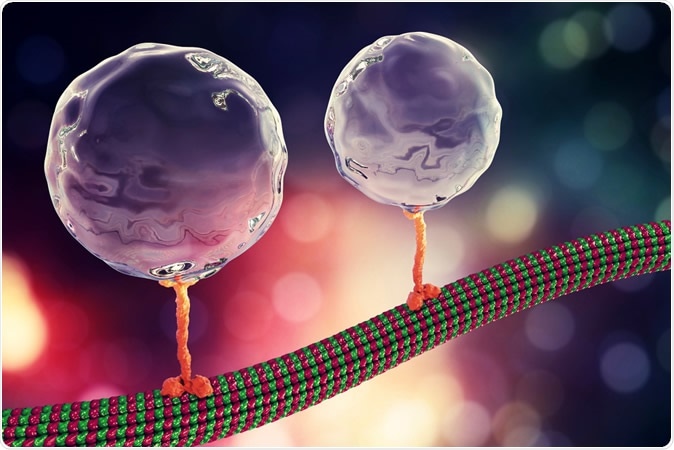
New insights into molecular motors could help treat neurological disorders
A new study reported in Nature Communications has discovered activators for molecules that act as motors to move materials around within nerve cells.
Nerve cells form the basis of the nervous system in animals, as they transfer information between the various sensory and effector organs of the body and the brain and spinal cord. However, this function relies heavily on the transport of several proteins and other molecules between various parts of the cell.
A nerve cell comprises a cell body, and multiple short branches called dendrites. It also has a long projection called the axon which carries signals away from the neuron. Nerve cells also have tiny tubular tracks composed of microtubules along which cargo is moved to and from the dendrites and axons by an attached molecular motor called KIF1C.
Human cells synthesize many types of motor molecules, called kinesins and dyneins. These carry cargo towards opposite ends of the cell, and both motors are often present on cargoes so that they can change direction if their progress is hindered.

Intracellular transport, kinesin motor proteins transport molecules moving across microtubules, 3D illustration. Kateryna Kon / Shutterstock
There are 45 kinesins, but only a few of them are actually understood, in terms of what sets the motors in action. Among them, KIF1C is the fastest motor in nerve cells, and is used for various processes within the neuron that require cargo transport in either direction. Defects in this motor underlie several debilitating nerve disorders, including hereditary spastic paraplegia, that is known to affect about 135,000 people the world over. Alzheimer’s disease and dementia are other conditions which are also linked to poorly functioning molecular motors.
KIF1C is a typical molecular motor, a protein which acts as a chemical-to-mechanical energy converter. This helps it to carry diverse loads in dense core vesicles within the cell. KIF1C also transports molecules called integrins that are important for cell adhesions.
KIF1C must remain at rest while the loading process is underway, and move the cargo once loading is complete until it is actually offloaded at the end of the trip. When compared to motor size, nerve cells are incredibly long, up to 3 feet. The transport system must be foolproof at the same time to avoid inhibition of nerve function.
The current study at the University of Warwickwas aimed at unraveling the mechanism of activation/inactivation of KIF1C. The scientists found that the inactive state of the KIF1C molecular motor is related to its autoinhibition, caused by the infolding of the molecule on itself. This causes its stalk to link to the part that attaches to the microtubules forming the tracks, and so keeps it out of action.
When its function is required, it utilizes two other proteins on the cargo, called PTNPN21 and Hook3. Either of these proteins attaches to the stalk of the KIF1C molecule, which results in its unfolding and activation. The outcome is that it slots into the tracks and starts to run along them, rather like a marathoner beginning the race at the starter’s gun.
When these proteins are present, they increase the rate at which the KIF1C lands on the tracks by about 40%. Thus the cargo is able to activate the KIF1C motor when loaded. This may be one way in which kinesins can transport cargo both ways without contradictory pulls. When these proteins are present, they can rescue the function of cells that lack adequate KIF1C expression.
If this discovery is confirmed, it could be used to start up or increase motor activity to shift required cargo within neurons to normalize the functioning in KIF1C-depleted nerve cell disorders. The team is currently considering work on hereditary spastic paraplegia.
Journal reference:
PTPN21 and Hook3 relieve KIF1C autoinhibition and activate intracellular transport, Nida Siddiqui, Alexander James Zwetsloot, Alice Bachmann, Daniel Roth, Hamdi Hussain, Jonathan Brandt, Irina Kaverina & Anne Straube, Nature Communications volume 10, Article number: 2693 (2019) DOI: 10.1038/s41467-019-10644-9, https://www.nature.com/articles/s41467-019-10644-9























.png)











No hay comentarios:
Publicar un comentario